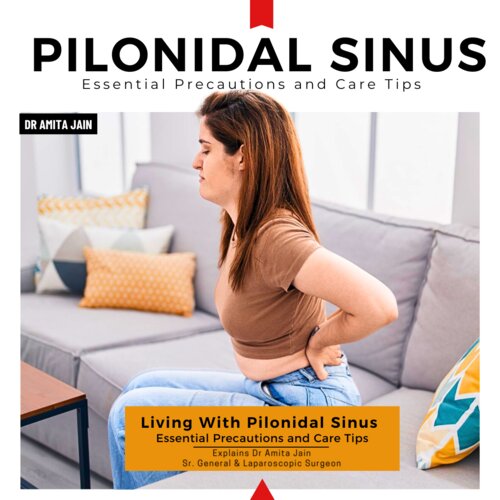Life moves fast, and in the chaos of daily responsibilities, health often takes a back seat. We push through discomfort, hoping things will get better on their own. But some health issues demand attention before they turn into something serious. Pilonidal sinus is one such condition. It starts as a seemingly harmless cyst near the tailbone but can quickly escalate into a painful, recurring problem that disrupts daily life.
If you have been struggling with a pilonidal sinus, you may be wondering—do I need surgery, or can I manage it with care? While surgery is often recommended for severe cases, many people successfully live with pilonidal sinus by following strict hygiene, lifestyle adjustments, and medical guidance.
Dr Amita Jain, a senior general and laparoscopic surgeon and one of the best doctors for pilonidal sinus treatment and surgery in Delhi, explains what kind of precautions and care should be taken to manage this condition effectively, minimize flare-ups, and improve the quality of life.
What do you know about the Pilonidal Sinus?
A pilonidal sinus also called a pilonidal cyst, is a small tunnel or cavity that forms in the skin at the top of the buttocks, near the tailbone. It develops when hair and debris become trapped in this area, leading to infection and inflammation. This condition can range from being asymptomatic to causing severe pain, swelling, redness, and the discharge of pus or blood.
Pilonidal sinuses are more common in young adult males and tend to recur frequently. People who sit for long hours, such as office workers or drivers, are at a higher risk of developing them. While some cases remain mild, treatment is usually required if an infection occurs.
1. Focus On Hygiene – For any disease or illness, hygiene plays a vital role in prevention, and pilonidal sinus is no exception.
- Keeping the area around your tailbone clean and free from bacteria is essential to avoid infection.
- Since hair and debris can accumulate in this region, regular cleansing is necessary.
- Shower daily and thoroughly wash the tailbone area, especially if you have hair in that region.
- Use a mild antibacterial soap and warm water to cleanse the skin without causing irritation.
- Avoid harsh scrubs or scented products that may trigger discomfort.
- After washing, ensure the area is completely dry by gently patting it with a soft towel instead of rubbing.
- Keeping the skin dry helps prevent bacterial growth and reduces the risk of infection.
2. Hair Removal and Prevention – Excessive hair growth in the sacral area contributes to the development and recurrence of pilonidal sinuses. Proper hair removal and hygiene can help prevent ingrown hairs, infections, and cyst formation. Here’s how you can manage pilonidal sinus effectively:
3. Hair Removal Strategies – You may do regular shaving for that you need to shave the sacral area weekly to prevent hair from entering cysts, via using a clean, sharp razor to reduce irritation and infections.
One may also apply Depilatory Creams as the chemical creams dissolve hair for easy removal which is a temporary but convenient option for individuals prone to pilonidal cysts the last one is Laser Epilation which is a long-term solution that destroys hair follicles using light energy that reduces the risk of recurrence after pilonidal sinus surgery and which is safe and effective, targeting multiple hair follicles in one session.
4. Preventing Hair-Related Issues – You may prevent it by Keeping the Area Hair-Free by trimming or removing hair to minimize the chances of trapped follicles. Use a Gentle Technique to avoid aggressive shaving or waxing that can irritate the skin. Please be careful to prevent nicks, cuts, or further complications.
5. Warm Compress – Warm Compress Therapy: Applying warm compresses to the affected area can provide relief and help manage the pilonidal sinus without surgery.
- Increases blood circulation to the area, promoting healing.
- Reduces inflammation and swelling.
- Encourages natural drainage of accumulated pus.
- Relieves pain and discomfort.
How to Apply a Warm Compress?
- Soak a clean cloth in warm water.
- Wring out excess water and ensure it is not too hot.
- Place the warm cloth on the affected area for 10-15 minutes.
- Repeat this process several times a day.
6. Sitz Bath – Soak in a warm sitz bath with 3-4 spoons of Epsom salt for 20 minutes to drain pus, relieve pain, and promote faster healing of an infected pilonidal cyst.
Say NO to Prolonged Sitting, sitting for extended periods puts pressure on the tailbone area, increasing the risk of flare-ups. For that Take breaks and stand and move every 30-60 minutes to reduce tailbone pressure and prevent cyst formation. While sitting Use a cushion a cushioned seat or an ergonomic chair to ease strain on the coccyx. Make sure to maintain posture and for that sit properly to minimize friction. And try to stay dry to avoid sweat buildup in the natal cleft to lower infection risk.
7. Conservative treatment – If a cyst is diagnosed early and isn’t causing severe pain or inflammation, a broad-spectrum antibiotic may be prescribed to reduce infection and discomfort. While these antibiotics target various bacteria and ease inflammation, they do not eliminate the cyst itself.
8. Comfortable Clothes – Wear loose clothes to avoid any irritation of the cyst. While it may seem challenging, managing a pilonidal sinus is possible with proper hygiene, hair removal, warm compresses, and lifestyle adjustments. Avoid prolonged sitting, wear loose clothes, use sitz baths, and follow medical advice to prevent flare-ups. With consistent care, you can minimize discomfort and improve your quality of life, even without immediate surgery.

Dr Amita Jain is one of India’s most distinguished and experienced female surgeons, known for her unmatched expertise in general and laparoscopic surgery. With over 29 years of surgical excellence, Dr Amita Jain has built a reputation for precision, compassionate care, and advanced surgical techniques.
Dr Amita Jain has successfully performed a wide range of complex general surgeries, including both open and minimally invasive procedures, with a strong focus on trauma care, onco-surgical techniques, and reconstructive surgeries. Her areas of specialisation include (including Gallbladder stone removal, appendix removal, hernia repair surgery, piles and fissure surgeries). She was the Professor of Surgery at the Army College of Medical Sciences and Base Hospital, Delhi Cantt. In 1994, she was commissioned asa Surgeon under the United Nations Mission in Congo. From 2020 to 2022, she worked with Bansals Hospital. Currently, Dr Amita Jain is the Senior General and Laparoscopic Surgeon at Rainbow Children Hospitals (Malviya Nagar, Delhi), Artemis Lite: Multi-Speciality Care Hospital (New Friends Colony, New Delhi) and at Rosewalk – Luxury Maternity Hospital in Delhi (Panchsheel Park, Delhi)
Call Us at +(91) 882-6615301
